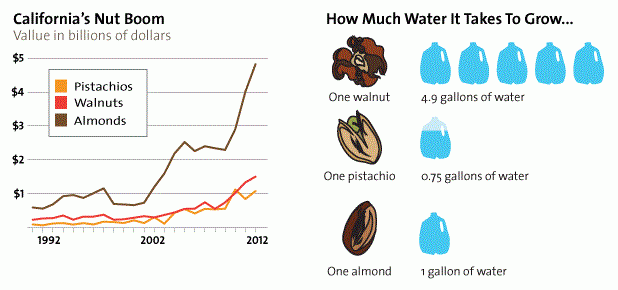Online Irrigation Calculator
Published on by Water Network Research, Official research team of The Water Network in Technology
Available online, free of charge, irrigation calculator allows almond growers to calculate irrigation schedules based on local growing conditions.
It is supported by the Almond Board of California (ABC) and was designed in partnership with University of California irrigation experts and the consulting firm SureHarvest.
 Over the years, the Board has spearheaded a number of water-saving efforts, and this is just one added in the wake of media criticism over the amount of water required to grow almonds.
Over the years, the Board has spearheaded a number of water-saving efforts, and this is just one added in the wake of media criticism over the amount of water required to grow almonds.
In a statement last year on sustainability, Richard Waycott, ABC president and chief executive officer, said growers over the last two decades had reduced the amount of water used to grow a pound of almonds by about 33 percent.
To use the irrigation calculator, growers enter information about their orchard, such as row and tree spacing, age, and percent canopy cover, along with optional inputs including soil texture and rooting depth.
The calculator automatically obtains weather data for necessary calculations from the nearest California Irrigation Management Information System (CIMIS) weather station, based on the zip code.
“It works for drip, micro sprinklers and (solid set) sprinklers,” he said. Nearly 70 percent of almond growers conserve water with drip irrigation or micro sprinklers.
To make it easier for calculator users to enter needed data, the software provides guidance for obtaining some of the required inputs.
Almonds being nearly a million acre crop in California put the industry in the eye of the storm of how resources are going to be used, particularly water.
The irrigation calculator complements a new effort by the Almond Board that encourages all almond growers to adopt practices to improve irrigation efficiency. An almond irrigation improvement continuum was developed by the Board in partnership with the University of California, California State University, and UC Cooperative Extension specialists.
It includes five practices including: measuring irrigation system performance and efficiency, estimating orchard water requirements based on evapotranspiration, measuring the amount of water applied, evaluating soil moisture, and evaluating water status.
Source: Western Farm Press
Media
Taxonomy
- Irrigation
- Online Instrumentation
- Nut Crops
- Irrigation Management
- Irrigation Scheduling
- Nuts
2 Comments
-
This application has endless possibilities; if it developed and shared without charge all types of farmers and even home owners could conserve our water resources.
-
Can it be used for paddy cultivation?